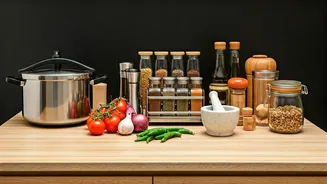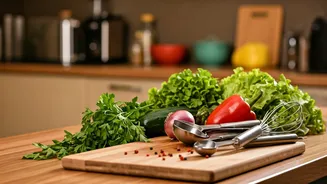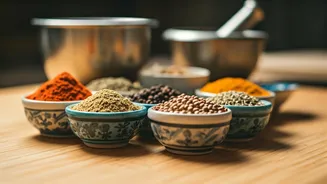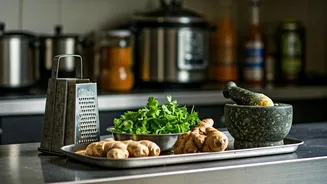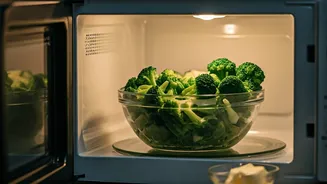Tea Strainer Cleaning
Cleaning a tea strainer can often feel tedious, but it doesn't have to be. For thorough cleaning, start by rinsing the strainer under hot water to dislodge
loose tea leaves. Next, create a paste using baking soda and water. Apply the paste to the strainer, allowing it to sit for a few minutes to loosen stubborn residue. Then, use a soft brush, like an old toothbrush, to scrub the strainer gently, paying attention to the finer mesh areas. Rinse thoroughly under hot water until all traces of the paste and tea residue are gone. Finally, dry the strainer completely before storing to prevent rust or mold. This routine ensures your tea strainer remains hygienic and effective, enhancing your daily tea enjoyment.
Pressure Cooker Safety
Using a pressure cooker safely is crucial for avoiding accidents and ensuring your food is cooked perfectly. Always check the vent pipe for any blockages before use; a blocked vent can lead to dangerous pressure buildup. Ensure the rubber gasket is in good condition and fits properly to create an airtight seal. Never fill the cooker more than two-thirds full, as this provides space for steam and prevents food from blocking the vent. Always release the pressure naturally after cooking, or use the quick-release method only if instructed in your cooker's manual. Never open the lid until the pressure has completely subsided. Regular maintenance, including cleaning the vent and checking the gasket, will extend the life of your pressure cooker and maintain its safety.
Beetroot's Clever Uses
Beetroot is not only a nutrient powerhouse but also incredibly versatile. To boost its daily inclusion, consider adding it to your morning smoothies for a natural energy boost and vibrant color. Roast beetroot with your favorite vegetables for a sweet and earthy side dish. Grate raw beetroot into salads for added texture and a pop of color; its slightly sweet flavor complements greens well. Beetroot juice can also be mixed into soups or stews to add depth and a healthy dose of vitamins. Moreover, beetroot can be pickled for a tangy snack or added to dips like hummus, creating a naturally colored and flavorful twist. Experimenting with beetroot in these creative ways ensures a consistent intake of its remarkable nutritional benefits.
Fixing Lumpy Curry
Dealing with a lumpy curry can be frustrating, but there are simple methods to salvage the dish and achieve a smooth consistency. One effective technique is to use an immersion blender or a regular blender to puree the curry until it's smooth. Work in batches if necessary, to avoid splattering. For a less intensive method, you can also strain the curry through a fine-mesh sieve, pressing gently to extract the liquid while leaving the lumps behind. Add the strained liquid back to the solids and reheat, stirring continuously. If the curry is too thick, add a little water or broth to adjust the consistency. Alternatively, you can add a spoonful of cream or yogurt to the curry, which can help to bind the ingredients and smooth out any lumps.
Curd's Creative Uses
Curd, a staple in Indian kitchens, offers versatile applications beyond its traditional consumption. When curd turns sour, it doesn’t mean it must be discarded. Sour curd can be used as a marinade for meats, adding a tangy flavor and tenderizing the protein naturally. In baking, sour curd can replace buttermilk or yogurt, giving cakes and breads a moist texture and slightly sour note. It is also a great ingredient in making raita or dips, adding a refreshing taste and creamy consistency to your meal. Moreover, sour curd can serve as a natural cleaning agent for your kitchen appliances. Its acidity helps remove grease and grime.
Bitter Gourd's Sweet Fix
Bitter gourd, despite its name, can be made more palatable with a few simple techniques. One primary method involves salting the sliced bitter gourd and letting it sit for about 30 minutes; this draws out excess moisture and some of the bitterness. Rinse the salted gourd thoroughly before cooking. Soaking the bitter gourd in buttermilk can also reduce bitterness; the lactic acid in buttermilk neutralizes some of the bitter compounds. Another tip is to combine bitter gourd with ingredients that balance its flavor, such as tomatoes, onions, and spices like turmeric and coriander. Avoid overcooking, as this can intensify the bitterness. Experimenting with these methods can make bitter gourd a more enjoyable part of your diet.
Tomato Puree Freshness
To ensure the freshness of homemade tomato puree, proper storage techniques are essential. After making the puree, let it cool completely before storing it. Transfer the puree into airtight containers or freezer bags. For longer storage, freezing is an excellent option; portion the puree into smaller amounts to use as needed. If storing in the refrigerator, ensure the container is tightly sealed to prevent the puree from absorbing other odors. Using fresh, ripe tomatoes and promptly processing them helps to retain their natural sweetness and prevent spoilage. Adding a small amount of salt or lemon juice to the puree can also enhance its preservation.
Cutlery Cleaning Tricks
Cleaning cutlery using common kitchen ingredients offers an eco-friendly and efficient alternative to harsh chemicals. For general cleaning, a mixture of warm water and a few drops of dish soap is usually sufficient. However, for stubborn stains or tarnish, create a paste of baking soda and water and gently scrub the cutlery. Soak cutlery in a solution of hot water, vinegar, and a little baking soda for a deeper clean. Let the cutlery sit for around 15 minutes before rinsing thoroughly. To eliminate water spots, immediately dry the cutlery with a soft cloth after washing. For silverware, polish with a mixture of baking soda and water or a commercial silver polish to restore its shine. Proper care and the right cleaning methods ensure your cutlery remains in excellent condition.
Okra's Longevity Tips
To keep okra fresh for an extended period, proper storage is vital. When buying okra, choose firm, unblemished pods. Store the okra in the refrigerator unwashed, as moisture can expedite spoilage. Place the okra in a paper bag or a loosely closed plastic bag to allow for some air circulation. If you intend to freeze okra, blanch it first by immersing it in boiling water for about 2-3 minutes, then immediately transfer it to an ice bath to stop the cooking process. Once cooled, dry the okra and store it in freezer bags, which helps maintain its freshness for several months. Avoid storing okra with fruits like apples or bananas, as these fruits release ethylene gas, which can accelerate the ripening and spoilage of vegetables.
Breadcrumbs' Cleverness
Breadcrumbs have a range of interesting applications in the kitchen, extending beyond their traditional use as a coating for fried foods. They can be added to meatloaf or meatballs, improving texture and binding the ingredients. For a crispy topping on casseroles or baked dishes, combine breadcrumbs with melted butter and sprinkle them over the top before baking. In thickening sauces and soups, breadcrumbs can be a subtle, effective addition. Moreover, breadcrumbs can also be used as a base for savory stuffings for vegetables, providing bulk and adding flavor. To enhance their taste, you can season the breadcrumbs with herbs, spices, or grated cheese, tailoring them to your specific dish.
